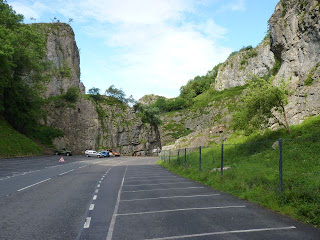The Johns family name is much more common in Britain than in the U.S. I read once that the name is thought to have originated in Cornwall, so Mary and I thought we'd better go see the place. The four-day holiday weekend for the Queen's Diamond Jubilee was the opportunity.
 |
| St. Ives |
 |
| St. Ives beach |
It's a long way to Cornwall, at the extreme southwestern tip of the island of Britain. We left early Friday morning and drove all morning at motorway speed (70 m.p.h.), then father as the motorway gave way to slower, two lane roads.
 |
| Coastal walk |
 |
| Zennor Head |
Cornwall has a history of Celtic culture holding out against invaders, similar to Wales and Scotland. There is even a native Cornish language, similar to Welsh. It is far more common to see Cornwall County flags flying here than Union Jacks, even on the Queen's Jubilee weekend.
 |
| Minack Theatre |
 |
| Gardens are a feature at Minack and everywhere in Cornwall |
There aren't a lot of attractions in Cornwall, per se, but many scenic spots, gardens, and places to walk. Our first stop was the seaside village of St. Ives -- a rather touristy spot known for its beaches and art galleries.
 |
| Land's End |
 |
| Walkway to Mousehole |
We drove to the tiny village of Zennor and walked cliffs at the Head, then on to Porthcurno to visit the Minack Theatre, an outdoor theater carved into the hillside overlooking the sea.
 |
| Low tide at Mousehole |
 |
| Mount Saint Michael |
From there, it was only a short drive on winding, narrow roads to Land's End -- which, as the name implies, is the western-most point in Britain -- and its iconic lighthouse. The sea is so treacherous here that they no longer attempt to reach this beacon by boat, but by the helicopter landing pad on top.
 |
| Kynance Cove |
We spent one night in a pleasant B&B at Penzance. It was supposed to be two nights, but thanks to a screw-up by Hotels.com, we had to move inland the second night, to a pretentious golf resort. Thus, we were not able to actually visit Mount Saint Michael, the castle overlooking Penzance harbor.
 |
| Trelissick Gardens |
We did, however, walk around the little fishing village of Mousehole (pronounced MOW-zul, where the first syllable rhymes with cow). At low tide, the boats here are beached.
 |
| Lanhydrock Estate |
We took a delightful hike at Kynance Cove, where sea and rocks meet. As we left Cornwall and crossed into Devonshire, the exploration continued.
 |
| Cotehele village |
We visited several National Trust sites: walked through Trelissick Gardens, toured the Lanhydrock Estate, and the estate and village at Cotehele.
 |
| Tapestries line the walls at Cotehele Hall |
Crossing the famous Dartmoor (setting for
The Hound of the Baskervilles and other spooky novels) we were greeted, appropriately, with thick fog. But we did get to see several of the famous wild horses of the moor.
 |
| Wild horses roam Dartmoor in the fog |
At Castle Drogo we toured "the last castle built in Britain." To be entirely correct, this is a manor house, completed in 1931, by a wealthy businessman with no title, but a romantic dream of nobility. Proving "they don't build 'em like they used to," this castle is crumbling due to leaking roofs, while castles ten times its age continue to stand.
 |
| "Castle" Drogo |
After a night in a dreadful little seaside tourist town in Somerset, we briefly visited Cheddar Gorge, but didn't shell out for the tourist trap tour of the caves where the cheese is aged.
 |
| Cheddar Gorge |
On the way home, we stopped at one of the most recently acquired National Trust sites, Croome Park, to see what an 18th century house looks like in the very early stages of renovation, and to see one of the half-dozen churches claiming to be the place where Shakespeare got married.
 |
| Croome Court |
 |
| Early renovations at Croome |
We put on a lot of miles, but had better weather than most of Britain this holiday weekend, on what will almost surely be our last outing into the English countryside of this year.





















No comments:
Post a Comment